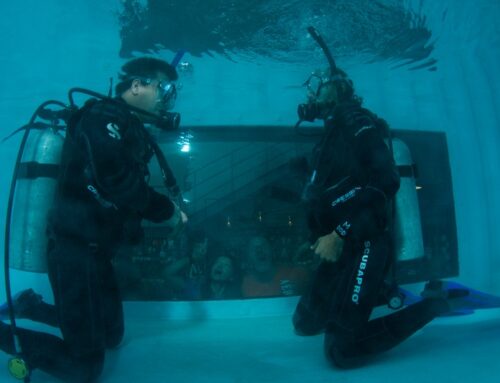Lets start with, what is sidemount diving?
It originated as a configuration for advanced cave diving, as it facilitates penetration of tight sections of cave, allows easy access to cylinder valves, provides easy and reliable gas redundancy, and tanks can be easily removed when necessary. These benefits for operating in confined spaces were also recognized by divers who conducted technical wreck diving penetrations.
These exploratory level cave divers began by making their own systems, using and adapting’off-the-shelf’ SCUBA equipment for their needs or creating configurations ‘from scratch’, based upon webbing harnesses and improvised bladders for buoyancy.
The concept of sidemounting cylinders originated from cave diving in the UK, during the 1960s. During ‘dry’ explorations of Wookey Hole, the River Axe and other underground systems, divers occasionally encountered submerged passages that blocked further exploration. These cavers began incorporating scuba equipment specifically to progress beyond underwater areas. However, because they operated in very confined spaces, and most exploration remained primarily ‘dry’, they began experimenting and improvising with extremely minimalist configurations, minimising bulk, allowing cylinders to be easily removed and replaced, and retaining the capacity to squeeze through the tightest restrictions.
During the 1970s the ‘English system’ began to be incorporated by American cave divers, operating in Florida. Those cave systems were predominantly flooded and involved prolonged swimming with SCUBA; thus more emphasis was paid towards developing the diving performance of the system, in particular buoyancy and trim. Divers required buoyancy control devices for extended finning and began shifting the location of the cylinders from against the thigh, up to the armpit and against the torso.
In the mid-1990s Lamar Hires designed the first commercial sidemount diving system and this was manufactured by Dive Rite. Dive Rite focused on the newly released ‘Transpac’ harness. Other cave divers continued to manufacture their own DIY configurations.
At this time, the use of sidemounted configuration was primarily restricted to a small number of exploration-grade cave pioneers
However Sidemount diving is now growing in popularity within the recreational diving community.
When I first seen people in Sidemount equipment, my thought was “oh tec-divers” how wrong could I have been. You don’t need to be a tec-diver to dive sidemount.
You do need special training to dive sidemount as the configuration is different from a single tank back mount. There’s also different BCD configuration to understand as well.
Sidemount diving offers some benefits in the flexibility of equipment. Unlike back-mounted cylinders, the sidemount diver has immediate access to, and can see, the regulators and tank valves of their cylinders. Sidemount diving configuration places the cylinders under the diver’s armpits, in line with their body, allowing the diver to pass through smaller restrictions than would be possible with back-mounted cylinders. The ability to remove tanks and push them in front allows the diver to pass through very small passages and holes when penetration diving – being limited only by the bulk of their bodies and diving suits.
Some divers will testify that sidemount diving configuration offers greater stability and easier-to-attain trim and control in the water. It is also claimed to be less physically tiring to carry, and get into, sidemount equipment than back-mounted doubles – especially when operating from a small boat or a rough shore entry.




